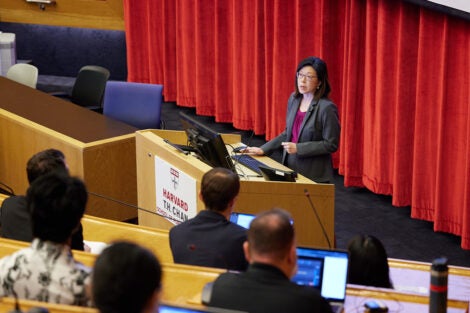November 2, 2023 – Two days before cancer patient Laura Greco was scheduled to give a presentation at Harvard T.H. Chan School of Public Health, she had a sudden stroke and ended up in the hospital. She was experiencing serious symptoms like slurred speech and face twitching, but they weren’t actually directly related to her cancer—rather, they were side effects of radiation therapy that she receives for the cancer.
Greco recovered in time to speak at the 26th annual John B. Little Symposium, where she shared her challenging journey as a patient since she was diagnosed in 2015, first with lung cancer and then metastatic brain cancer. In addition to radiation, she has gone through multiple rounds of surgery and chemotherapy for her recurring brain tumors.
“What did the drugs and radiation allow me to do? They allowed me to live,” she said. However, she also emphasized the wide range of devastating side effects that have accompanied her treatments. “I think we can all agree that’s really, really frightening that stroke is a side effect of radiation. You’ve got to fix this problem—patients are suffering,” she said.
Greco’s talk was part of an afternoon of presentations by radiation science researchers who discussed the latest advances in how to improve brain radiation therapy so that it better targets tumors and limits side effects on healthy cells. The October 27 event was organized by the John B. Little (JBL) Center for Radiation Sciences, named for the late John B. Little, the former James Stevens Simmons Professor of Radiobiology, Emeritus.
“The symposium really embodies a theme that resonates with us here at the Harvard Chan School, which is bringing together diverse disciplines and modes of research to address the biggest public health challenges,” said Jane Kim, interim dean of the faculty and dean for academic affairs, in opening remarks. Additional welcome remarks were delivered by JBL Center co-directors Zachary Nagel, associate professor of genomics and cancer biology, and Kristopher Sarosiek, associate professor of radiation biology and cell death.
Currently, radiation is often the best option for treating brain tumors, since surgeries may not be possible and drugs are not as effective, according to Helen Shih, an oncologist and the director of the Central Nervous System and Eye Services at Massachusetts General Hospital. However, radiation also injures the surrounding normal brain tissue, leading to side effects including fatigue, headaches, nausea, and permanent hair loss.
“The most feared are the neurocognitive deficits in memory, attention, executive function—these things that make us human,” Shih said.
Researchers are taking multiple approaches to address radiation’s side effects. For example, Shih is working to improve how radiation is delivered to the brain. She treats brain cancer with proton radiation rather than traditional x-rays, since they are better at specifically targeting tumors and avoiding other brain tissue. Meanwhile, Sarosiek is investigating why healthy neurons in children are particularly sensitive to radiation. He has found that, in children, cells die off as part of normal development, but that radiation can cause the process to go into overdrive.
Scott Floyd, the Gary Hock and Lyn Proctor Associate Professor of Radiation Oncology at Duke University, shared his work on developing a better lab model for studying brain tumors. Current methods include culturing brain tumor cells in a petri dish, which does not accurately mimic how the cells behave in the body, or grafting the cells into animals such as mice, which is a long and expensive process. Floyd’s model sits somewhere in between—taking slices of healthy rat brain tissue and culturing patient tumor cells on top, a relatively quick method that better maintains the tumor cells’ natural behavior. He calls it the “Swiss Army Knife” of models, one that is flexible enough to test many different patients’ tumors and their specific genetic profiles.
Floyd has used the model to investigate the differences in how radiation affects both tumor cells and healthy neurons, as well as which chemotherapy drugs may be most effective for specific patient tumors.
“This assay can give us the ability to test therapeutic interventions directly on a patient tissue in a short period of time that might make it reasonable to even change someone’s therapy,” Floyd said.
– Jay Lau
Photo: Kent Dayton
